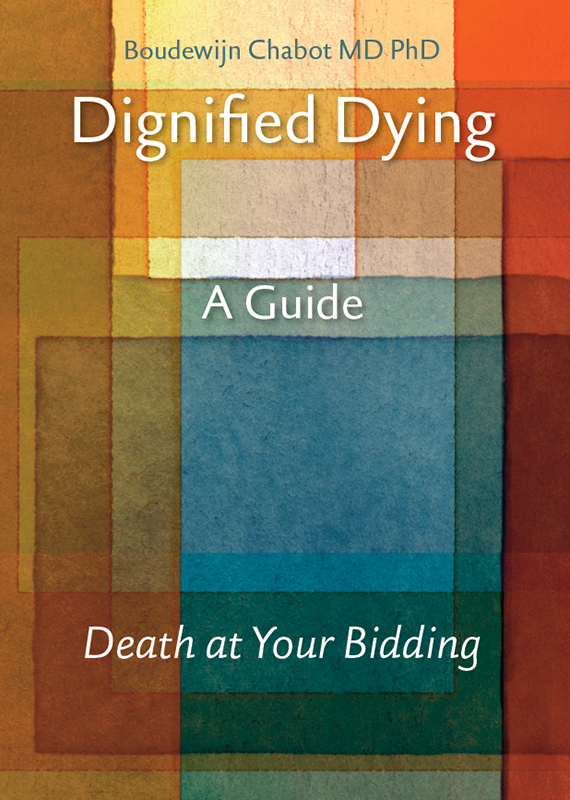The books authored by Boudewijn Chabot on this subject have been published in different languages andvarious ways. Digital versions are offered through this website, while printed versions are available through a print on demand service or through an external sales channel such as the publisher. Links to these external parties will be provided on the product page.
| UITWEG 15e herziene druk | |
| Dignified dying | |
| Stopping Eating and Drinking | |
| De Weg Kwijt |
UITWEG

Augustus 2022 is de 15e herziene druk van het boek UITWEG verschenen.
In het boek Uitweg beschrijven psychiater Boudewijn Chabot en Wim Graafland drie manieren om waardig en omringd door dierbaren afscheid van het leven te nemen: stoppen met eten en drinken, de medicijn- en de heliummethode. Ook gaat hij in op eventuele problemen met justitie na het overlijden en hoe die voorkomen kunnen worden. Sinds de verschijning in 2010 heeft Uitweg voor een aardverschuiving gezorgd. Waar hulp bij zelfdoding voorheen onbespreekbaar was, is het artsen nu toegestaan om (als euthanasie niet mogelijk is) de in dit boek behandelde methoden ter sprake te brengen bij patiënten met een doodswens. Zelfeuthanasie in gesprek met en in aanwezigheid van de naasten verschilt fundamenteel van eenzame en verminkende zelfdodingen.
‘Een naslagwerk voor iedereen die zich wil oriënteren in deze materie.’ (NRC Handelsblad)
Dignified Dying

This book will stimulate communication between very ill or very old persons and their relatives and friends. It may give peace of mind to all involved in the difficult decision how to die with dignity. Thanks to this Guide any layperson can take control of such an intimate process as his own death. It provides detailed information on the medication method and the use of inert gases for a self-chosen and dignified death.
Though the Dutch legislation on physician-assisted dying is the most liberal in the world, it does not fulfill the wishes of those who strive for more autonomy in dying. Dr. Chabot’s position is that physician-assisted dying and dignified self-help routes to death are complementary approaches, rather than mutually exclusive alternatives. Only together can they provide an answer to the demand that a dignified, self-directed death be accessible for those who want it at a time of their choosing.One obstacle to productive discussion among right-to-die experts is that there is no consensus on what most people regard as ‘dying well’. Dr. Chabot discusses shared opinions about ‘good’ or ‘bad’ death that have emerged from sociological studies in a wide variety of societies. This provides the empirical base for Chabot’s seven SESARID criteria that apply to what most people would consider an ideal autonomous method: dying asleep at home in one’s intimate circle rather than dying a lonely death for fear of risks to those present.
Recommendations Faye Girsh, former president of the World Federation of Right-to-Die Societies, wrote on Amazon: “I still find it confusing what to advise people about the best way to have a peaceful death when help from a doctor is unobtainable, as it is for most people around the world.”
“Chabot’s new book I found to be a further clarification of the major methods with more scientific evidence, clarification of some of the more dubious methods that people talk about, and a clear description of what is needed. “Chabot looks into the future when the number of old persons and patients with long-term chronic disease and impending dementia will engulf the medical profession with their needs to die peacefully.”
“Taking it out of the hands of already reluctant doctors and empowering individuals, families and professional end-of-life counselors with this information is the wave of the future, as Derek Humphry did with his pioneering, Final Exit. Chabot’s book, though quite accessible for the lay reader, offers more scientific data and embeds the information in an historical context.”
Stopping Eating and Drinking – a guide

The aim of this book is to stimulate communication between patients at the end of lives, their relatives, doctors and nurses.These are the people who become involved when elderly or very ill people refuse artificial nutrition and hydration. My hope is to give some peace of mind to people who are very old or ill and who have a well-considered and unwavering wish to die, even after discussing it with their loved ones. This peace of mind will come from the knowledge that they can take control of such a very intimate process as their own death, simply by refusing to drink. Relatives, supervised by an experienced nurse, can provide the mouth care necessary to keep the process bearable. For countless generations, the elderly and ill everywhere in the world have taken this route in silence. Only now, with the know-ledge we have, can it also be made a peaceful and dignified one.
De weg kwijt

In zijn boek “De weg kwijt” spreekt Boudewijn Chabot zorg uit over de staat van de euthanasiewet.
De acceptatie van euthanasie bij allerlei nare lichamelijke ziekten is enorm toegenomen. In De weg kwijt legt Boudewijn Chabot de schaduwkant hiervan onder een vergrootglas.
Hoogleraar Anne-Mei The valt Chabot bij en demonstreert in haar Proeftuin Dementie hoe je anders kunt omgaan met de angst voor dementie. Hoogleraar Jim van Os legt uit hoe het komt dat psychiatrische behandeling geen hoop meer biedt aan mensen die worstelen met de dood.

